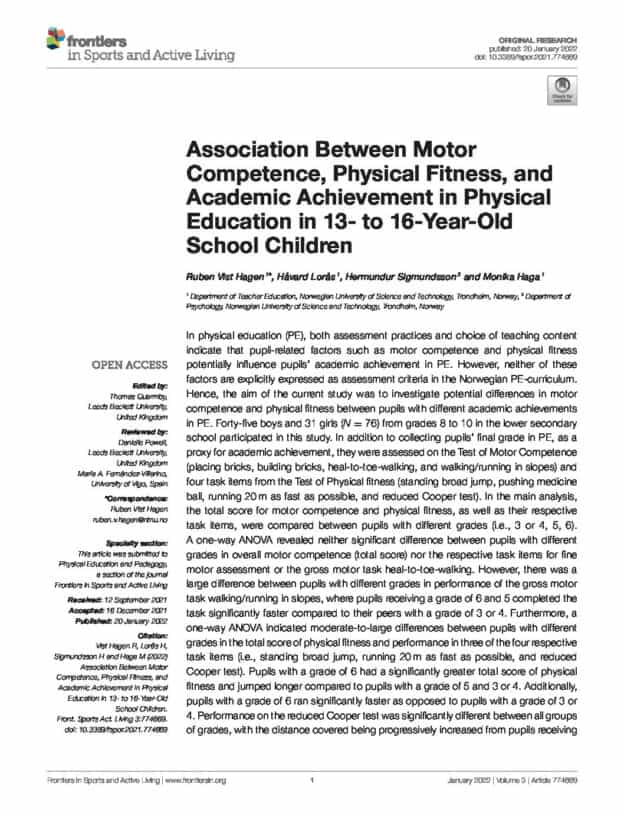Abstract
In physical education (PE), both assessment practices and choice of teaching content indicate that pupil-related factors such as motor competence and physical fitness potentially influence pupils’ academic achievement in PE. However, neither of these factors are explicitly expressed as assessment criteria in the Norwegian PE-curriculum. Hence, the aim of the current study was to investigate potential differences in motor competence and physical fitness between pupils with different academic achievements in PE.
Forty-five boys and 31 girls (N = 76) from grades 8 to 10 in the lower secondary school participated in this study. In addition to collecting pupils’ final grade in PE, as a proxy for academic achievement, they were assessed on the Test of Motor Competence (placing bricks, building bricks, heal-to-toe-walking, and walking/running in slopes) and four task items from the Test of Physical fitness (standing broad jump, pushing medicine ball, running 20 m as fast as possible, and reduced Cooper test). In the main analysis, the total score for motor competence and physical fitness, as well as their respective task items, were compared between pupils with different grades (i.e., 3 or 4, 5, 6). A one-way ANOVA revealed neither significant difference between pupils with different grades in overall motor competence (total score) nor the respective task items for fine motor assessment or the gross motor task heal-to-toe-walking. However, there was a large difference between pupils with different grades in performance of the gross motor task walking/running in slopes, where pupils receiving a grade of 6 and 5 completed the task significantly faster compared to their peers with a grade of 3 or 4.
Furthermore, a one-way ANOVA indicated moderate-to-large differences between pupils with different grades in the total score of physical fitness and performance in three of the four respective task items (i.e., standing broad jump, running 20 m as fast as possible, and reduced Cooper test). Pupils with a grade of 6 had a significantly greater total score of physical fitness and jumped longer compared to pupils with a grade of 5 and 3 or 4. Additionally, pupils with a grade of 6 ran significantly faster as opposed to pupils with a grade of 3 or 4. Performance on the reduced Cooper test was significantly different between all groups of grades, with the distance covered being progressively increased from pupils receiving a grade of 3 or 4 to 6, respectively.
These results indicate that physical fitness levels and one component of motor competence may influence pupils’ academic achievement in PE. Since neither certain levels of gross motor competence nor physical fitness are explicitly stated as assessment criteria in the Norwegian PE curriculum, these findings may indicate a lack of alignment between PE-teachers’ assessment practice and the curriculum’s intentions. It is argued that PE-teachers should be aware of how these individual constraints may influence pupils’ academic achievement in PE so that all pupils are given equal opportunities to meet the described learning outcomes.



Responses